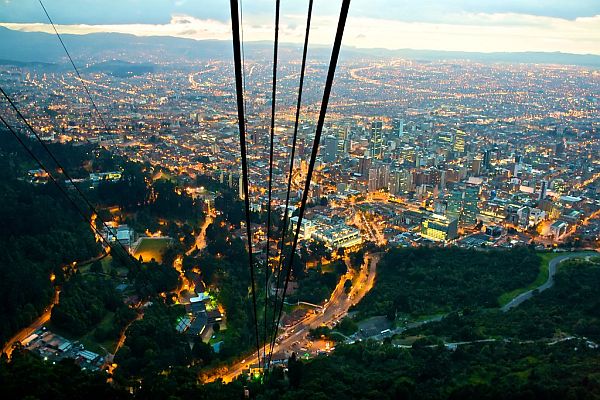‘Well, it’s just that no-one has ever wanted to come here,’ my cuñada tells me. That’s her response when I ask her why so many people are so anxious about the Venezuelans entering Colombia via the land border in the north. Cuñada means sister-in-law in Spanish, but she isn’t really my sister-in-law. My boyfriend and I aren’t married – but he tells me that it would be unusual not to use the term here.
In a country that still tops some lists of the most dangerous places in the world, the people aren’t used to the idea that their nation might be an attractive destination to anyone. There is the familiar fear about jobs being taken, about an increase in crime and a threat to the local ‘way of life,’ but – unlike Australians – Colombians haven’t stoked their nationalistic sentiments for multiple generations.
In my boyfriend’s family living room, in a lower middle-class barrio in the South of the city, the news focuses on crimes committed by Venezuelans: robberies, prostitution, a murder. Meanwhile, a World Bank study shows that, while perception of insecurity has increased, crime levels have not. In fact, they have decreased in some areas. Nevertheless, xenophobia is rife.
When we leave the house, my suegra (or mother-in-law) talks to all the Uber drivers about the Venezuelan crisis – not the one over the border but the one taking place right here. The drivers all agree that the borders should be closed. Even the venezuelano, who makes sure to emphasise that he has been living in Colombia thirty years. In the same breath, he talks about how horrible the situation is in the United States for his cousin, who just wants a better life. No one appears to see the irony. My mind goes to the hateful words scrawled on mosques and temples back home.
Faced daily with the sights of families walking the highways, carrying everything they own in suitcases and plastic bags, I am more aware of the humanitarian plight of migrants here than I ever have been in Australia. Colombia has no offshore detention centres in which to keep people out of sight. My boyfriend and I scale Monserrate, the largest peak in Bogotá, and look out over a fractured urban landscape. This is a city cut into the mountains with a population of ten million.
From up here, it is impossible to tell the mansions from the barrios marginales. I briefly understand where the fear of letting people in comes from. My boyfriend’s comments drift down over the city: ‘It makes sense. Your government doesn’t want the hospitals to be like ours: overflowing. The crime to be like ours.’ While, I hear him, in my heart, I can’t reconcile this view with the indefinite despair inflicted in places like Nauru. Surely we have enough migrant history and experience to see the positives and manage the maybes?
The Colombian Government doesn’t reflect the attitudes of the majority of people I speak to. President Iván Duque Márquez seems to welcome the migrants, and has granted legal access to more than half a million Venezuelans, with another 240,000 awaiting approval. Recent reports show there could be up to four million Venezuelans living in Colombia by 2021. By contrast, Australia has settled 7.5 million migrants in total since 1945. In 2015-16, our country issued only 17,555 humanitarian visas. Watching the news broadcast in Bogotá, I learn that somewhere between three and ten thousand people cross the border every day in Cucuta, while back home a motion to support the closure of offshore detention centres is shut down before being heard.
In the short term, this mass migration is certainly placing pressures on Colombia’s services, social institutions and labour markets, often affecting the most vulnerable communities the most. However, the same World Bank study cited above shows that, if managed well, migration will have a positive impact on economic growth. For every 500,000 people of working age that migrate to the country, economic growth could be accelerated by 0.2 percentage points. Perhaps this is why the Colombian government has implemented measures to mitigate impacts on receiving areas, and has adapted its legal and institutional frameworks quickly to adjust its response capacity. Or perhaps it is because, not so long ago, when Colombians fled from guerrilla warfare and cartel related violence, the flow moved in the opposite direction.
I arrive back home amid fiery debates over the Medevac bill, which will allow asylum seekers to be evacuated to Australia for medical treatment. I am not naïve enough to think that what I witnessed in another country can so easily be applied here, or that everything in Colombia will be smooth sailing. However, I am more conscious of the fact that, while fear may be universal, so too can be humanity. I hear the words of my cuñada and feel sad to be from a place where everyone wants to go, but so few can.
Donald Trump has been labelled a monster on the international stage for wanting to erect a wall to keep migrants out of the United States. In Australia Scott Morrison has pledged to reverse the Medevac bill if he’s returned to government, and there is no sign of the ‘stop the boats’ policies going away. As the elections loom nearer, I can’t help thinking that our wall of water didn’t need to be constructed: it flows through our institutions, social and political, which makes it all that much harder to dismantle.
Image: View of Bogotá by Tijs Zwinkels






